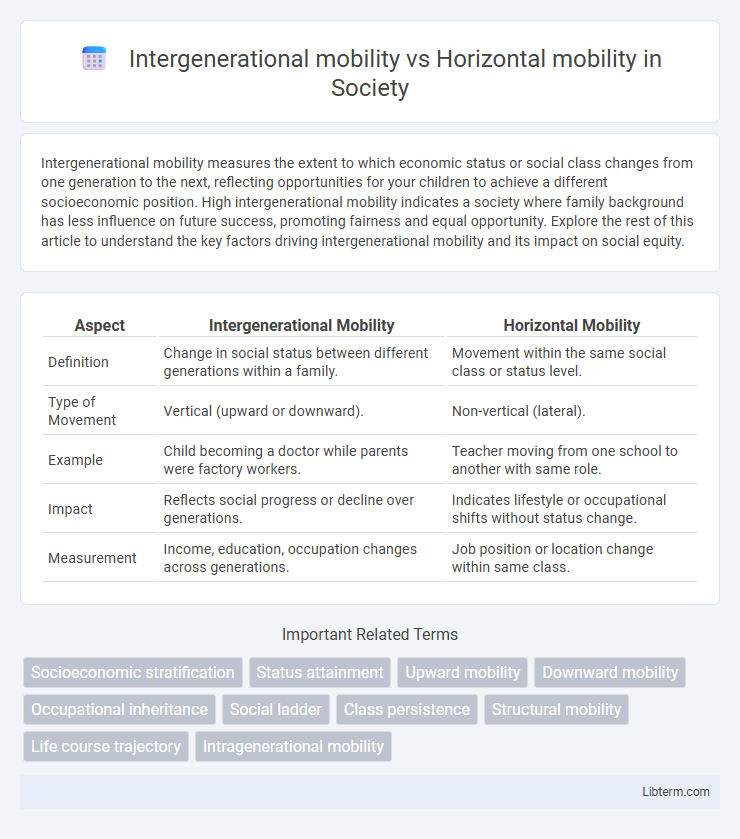Intergenerational mobility measures the extent to which economic status or social class changes from one generation to the next, reflecting opportunities for your children to achieve a different socioeconomic position. High intergenerational mobility indicates a society where family background has less influence on future success, promoting fairness and equal opportunity. Explore the rest of this article to understand the key factors driving intergenerational mobility and its impact on social equity.
Table of Comparison
| Aspect | Intergenerational Mobility | Horizontal Mobility |
|---|---|---|
| Definition | Change in social status between different generations within a family. | Movement within the same social class or status level. |
| Type of Movement | Vertical (upward or downward). | Non-vertical (lateral). |
| Example | Child becoming a doctor while parents were factory workers. | Teacher moving from one school to another with same role. |
| Impact | Reflects social progress or decline over generations. | Indicates lifestyle or occupational shifts without status change. |
| Measurement | Income, education, occupation changes across generations. | Job position or location change within same class. |
Understanding Social Mobility: An Overview
Intergenerational mobility measures changes in social status between generations, reflecting economic or occupational shifts from parents to children, while horizontal mobility involves movement within the same social strata or occupational level without altering overall social hierarchy. Understanding social mobility requires analyzing both forms to assess how individuals or families move within or across social classes, highlighting barriers and opportunities for economic advancement. Evaluating factors such as education, income, and occupation provides insight into the dynamics of social mobility and its impact on societal inequality.
Defining Intergenerational Mobility
Intergenerational mobility refers to the changes in socioeconomic status or social class between different generations within a family, highlighting how children's economic positions compare to their parents'. It measures the extent to which social advantages or disadvantages are transmitted across generations. This concept is crucial in understanding long-term social inequality and the effectiveness of social policies in promoting equal opportunities.
What Is Horizontal Mobility?
Horizontal mobility refers to the movement of individuals or groups within the same social or economic status, without significant changes in wealth, power, or prestige. It often involves shifts in occupation, location, or social circles that do not alter the overall social class. Unlike intergenerational mobility, which measures changes in social status between generations, horizontal mobility emphasizes lateral transitions within the same social stratum.
Key Differences Between Intergenerational and Horizontal Mobility
Intergenerational mobility measures changes in social status between different generations within a family, reflecting long-term shifts in socioeconomic position, while horizontal mobility involves movements within the same social stratum or occupational category, such as changing jobs with similar status or income. Key differences include the temporal scope, with intergenerational mobility examining shifts across parent-child generations and horizontal mobility focusing on lateral changes within an individual's lifetime. Intergenerational mobility often indicates systemic changes in society's structure, whereas horizontal mobility highlights individual or group flexibility without altering overall social ranking.
Measuring Intergenerational Mobility: Methods and Indicators
Measuring intergenerational mobility involves analyzing changes in socioeconomic status between parents and their offspring through methods like income elasticity, which quantifies the correlation of earnings across generations, and transition matrices that track movement between defined social classes. Key indicators include intergenerational income elasticity coefficients, which estimate the persistence of economic advantage or disadvantage, and rank-rank correlations that assess relative positional changes over time. These measures contrast with horizontal mobility, which focuses on shifts within the same socioeconomic level without significant status change.
Factors Influencing Horizontal Mobility
Horizontal mobility involves a change in social position or occupation within the same social stratum, influenced primarily by factors such as education level, technological advancements, geographic relocation, and labor market dynamics. Unlike intergenerational mobility, which tracks movement across different social classes over generations, horizontal mobility emphasizes shifts within a similar socioeconomic status, often prompted by shifts in industry demand or organizational restructuring. Educational qualifications, regional economic opportunities, and organizational culture significantly shape an individual's ability to undertake horizontal mobility.
The Role of Education in Social Mobility
Intergenerational mobility measures changes in social status between generations, while horizontal mobility involves shifts within the same social stratum, both influenced significantly by education. Education serves as a critical lever for intergenerational mobility by providing skills and credentials that elevate socioeconomic status across family lines. Horizontal mobility often reflects lateral moves such as career changes within a social class, where educational attainment supports maintaining or slightly altering occupational roles without drastic class shifts.
Economic Impacts of Mobility Types
Intergenerational mobility significantly influences long-term economic growth by enabling individuals from lower-income families to access better education and employment opportunities, thereby reducing income inequality across generations. Horizontal mobility, involving shifts within the same social class or occupational group, affects economic stability and consumer behavior without altering overall income distribution. High intergenerational mobility promotes a dynamic labor market and innovation, while horizontal mobility mainly supports adaptability in the workforce during economic fluctuations.
Policy Interventions for Enhancing Mobility
Policy interventions targeting intergenerational mobility often emphasize education accessibility, progressive taxation, and social welfare programs to reduce economic disparities passed from parents to children. Enhancing horizontal mobility involves workforce retraining, geographic relocation support, and anti-discrimination laws to facilitate career shifts and lateral employment movements. Effective frameworks integrate both strategies, improving opportunities across generational lines and enabling broader occupational mobility within the labor market.
Future Trends in Social Mobility Research
Future trends in social mobility research increasingly emphasize the distinctions between intergenerational mobility, which measures changes in socioeconomic status across generations, and horizontal mobility, reflecting movement within the same social strata. Advances in data analytics and longitudinal studies enable more precise tracking of economic, educational, and occupational shifts, revealing nuanced patterns of mobility influenced by globalization, technological change, and policy shifts. These emerging insights highlight the importance of understanding how structural factors and individual agency interact to shape social mobility trajectories across different demographic groups.
Intergenerational mobility Infographic

 libterm.com
libterm.com